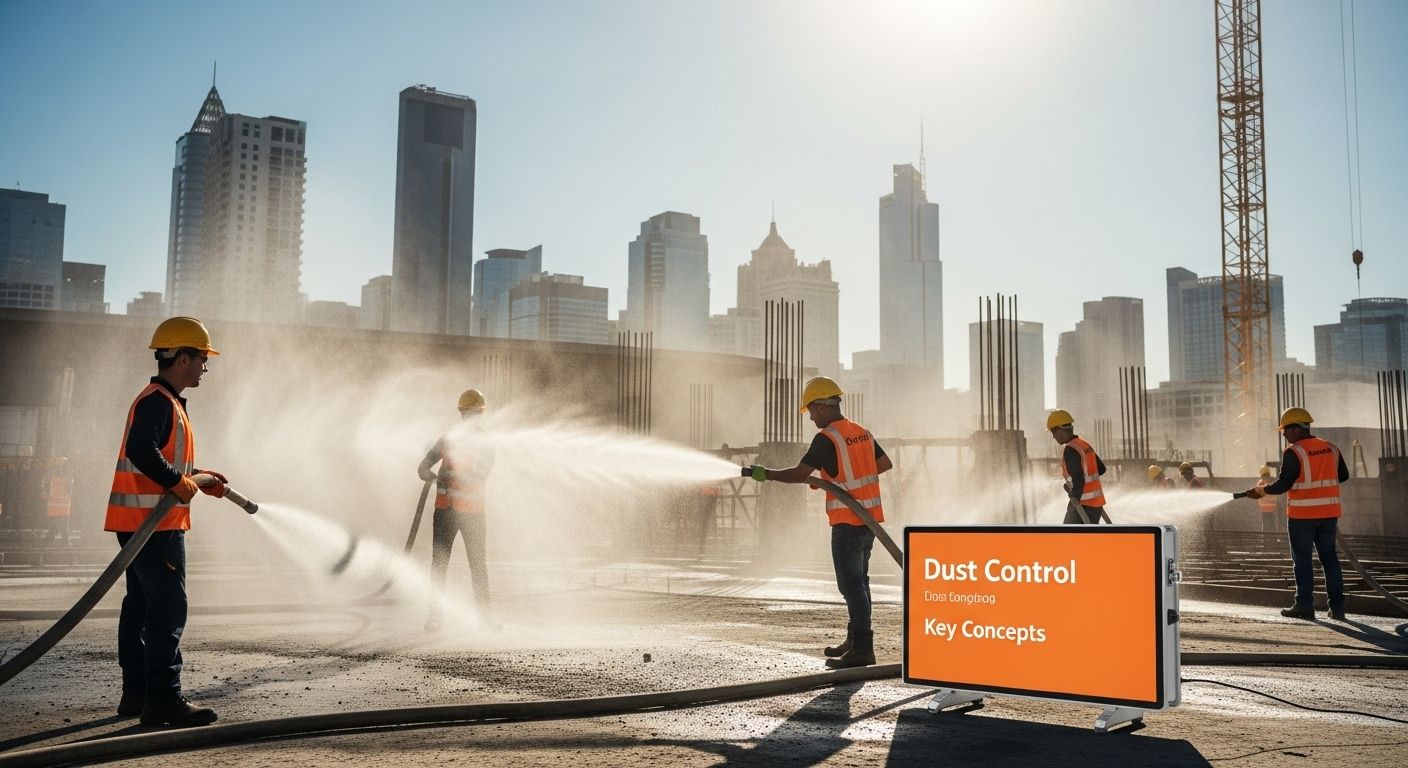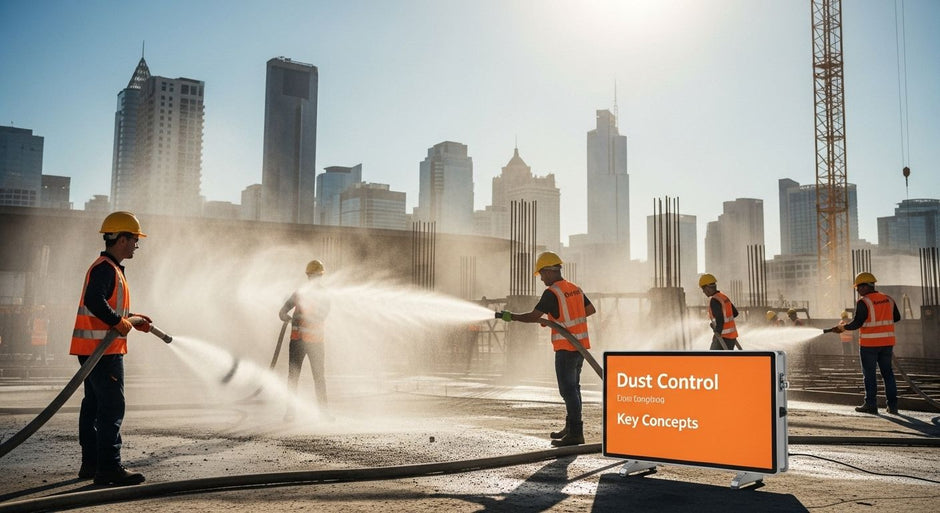
Construction dust may look harmless but the hidden threat it poses is massive. Shockingly, exposure to respirable crystalline silica can increase the risk of deadly lung diseases and even lead to lung cancer according to research. Many people assume a bit of dust is just an occupational nuisance but strict dust control is not just a rule. It could be the difference between protecting site workers’ lives and risking irreversible health damage.
Table of Contents
- What Is Dust Control In Construction And Why Is It Important?
- The Impact Of Dust On Health And The Environment
- How Dust Control Measures Work: Techniques And Technologies
- Key Concepts In Dust Control: Regulations And Best Practices
Quick Summary
| Takeaway | Explanation |
|---|---|
| Effective dust control protects worker health. | Construction dust can cause serious respiratory illnesses, making dust control essential for worker safety. |
| Dust control is mandatory for environmental compliance. | Regulations require construction sites to manage dust to prevent air quality degradation and ecological harm. |
| Use water-based solutions for dust suppression. | Techniques such as continuous wet cutting and spray systems help reduce airborne particles effectively. |
| Implement mechanical collection systems. | Advanced filtration systems like HEPA vacuums can significantly lower dust exposure at the source. |
| Follow regulatory exposure standards. | Adhering to OSHA’s exposure limits and requirements ensures adequate protection for workers against dust hazards. |
What is Dust Control in Construction and Why is it Important?
Dust control in construction represents a critical safety and environmental management strategy designed to minimise airborne particulate matter generated during building, renovation, and infrastructure development activities. These strategies aim to protect worker health, maintain regulatory compliance, and prevent environmental contamination.
Understanding Construction Dust Hazards
Construction sites produce significant quantities of respirable dust through activities like demolition, cutting, grinding, and material handling. These dust particles, particularly silica-containing materials, pose severe health risks. According to OSHA, exposure to construction dust can lead to serious medical conditions:
- Respiratory diseases like silicosis
- Lung cancer
- Chronic obstructive pulmonary disease (COPD)
- Potential immune system complications
Why Dust Control Matters
Effective dust control extends beyond worker protection. Environmental and regulatory considerations make it a mandatory practice. EPA research highlights that particulate matter can:
- Penetrate deep lung tissues
- Enter human bloodstreams
- Reduce overall air quality
- Potentially damage local ecosystems
Construction professionals must implement comprehensive dust management strategies that combine engineering controls, proper equipment, and systematic work practices to mitigate these multifaceted risks. Proactive dust control is not just a regulatory requirement but a fundamental responsibility to protect human health and environmental integrity.
The Impact of Dust on Health and the Environment
Dust generated from construction activities represents a complex environmental and health challenge with far-reaching consequences beyond immediate work sites. The microscopic particles produced during building, demolition, and infrastructure projects pose significant risks to human physiology and ecological systems.
Human Health Consequences
Construction dust contains multiple hazardous particles that can cause severe medical complications. CDC research demonstrates that respirable crystalline silica can trigger profound health challenges:
- Irreversible lung inflammation and scarring
- Increased risks of tuberculosis
- Potential development of lung cancer
- Chronic obstructive pulmonary disease (COPD)
- Potential kidney disease progression
Environmental Degradation Mechanisms
Beyond human health, construction dust significantly impacts environmental quality. EPA analysis reveals multiple ecological disruption pathways:
- Acidification of lakes and water streams
- Nutrient balance alterations in coastal ecosystems
- Soil nutrient depletion
- Potential damage to sensitive forest and crop systems
- Reduction of atmospheric visibility
Comprehensive dust management is not merely a regulatory requirement but a critical intervention to protect both human health and environmental sustainability. Construction professionals must recognize dust as a complex pollutant with multifaceted implications, necessitating proactive, systematic control strategies that mitigate potential long-term consequences.
This table summarises the main health and environmental hazards linked to construction dust exposure, offering a clear side-by-side view of their distinct impacts.
| Hazard Type | Description | Examples of Consequences |
|---|---|---|
| Human Health | Exposure to dust containing respirable crystalline silica and other particulates | Lung disease, cancer, COPD, kidney disease |
| Environment | Particulate matter affecting air, water, soil, and ecosystems | Acidified water bodies, reduced soil nutrients, poor visibility |
How Dust Control Measures Work: Techniques and Technologies
Dust control measures in construction represent sophisticated engineering and technical interventions designed to capture, suppress, and minimise airborne particulate matter through strategic methodologies. These techniques combine mechanical, physical, and technological approaches to mitigate dust generation and transmission across various work environments.
Water-Based Dust Suppression Technologies
Water represents a primary and fundamental dust control mechanism. OSHA regulations recommend integrated water-delivery systems that continuously feed moisture to cutting surfaces and work areas. Effective water-based strategies include:
- Continuous wet cutting techniques
- Integrated spray systems on power tools
- High-pressure misting mechanisms
- Surface dampening before aggressive work activities

Mechanical Dust Collection Systems
Mechanical extraction represents another critical dust management approach. Advanced technologies focus on capturing dust directly at its source through sophisticated filtration mechanisms. According to NIOSH research, effective dust collection systems can reduce respirable crystalline silica exposures by up to 90% when correctly implemented:
- On-tool dust extraction systems
- HEPA-filtered vacuum attachments
- Enclosed dust collection shrouds
- Positive pressure ventilation equipment
Comprehensive dust control demands a multifaceted approach integrating technological innovation, engineering controls, and systematic workplace practices. Construction professionals must select and implement dust management strategies tailored to specific work environments, material characteristics, and potential exposure risks.
The following table compares key dust control techniques in construction, helping readers quickly understand the differences between water-based suppression methods and mechanical collection systems.
| Technique | Principle of Operation | Example Applications | Effectiveness |
|---|---|---|---|
| Water-based Dust Suppression | Uses water to bind dust particles, preventing them from becoming airborne | Wet cutting, surface dampening, misting systems | Highly effective for reducing visible dust |
| Mechanical Dust Collection Systems | Captures dust at the source through filtration and extraction | On-tool extraction, HEPA vacuums, dust shrouds | Can reduce respirable silica by up to 90% |
Key Concepts in Dust Control: Regulations and Best Practices
Regulatory frameworks and industry best practices form the cornerstone of effective dust control strategies in construction environments. These guidelines provide comprehensive standards designed to protect worker health, ensure environmental safety, and establish systematic approaches to managing airborne particulate risks.
Regulatory Exposure Standards
OSHA regulations establish critical benchmarks for dust control and worker protection. Key regulatory parameters include:
- Permissible exposure limit of 50 µg/m³ as an 8-hour time-weighted average
- Mandatory action level set at 25 µg/m³
- Requirements for written exposure control plans
- Mandatory medical surveillance for high-risk workers
- Comprehensive training and documentation protocols
Implementation Best Practices
NIOSH guidance recommends a multifaceted approach to dust management that goes beyond basic compliance. Effective implementation strategies encompass:
- Integrated wet suppression techniques
- Local exhaust ventilation systems
- Task-specific dust isolation methods
- Systematic filter maintenance
- Comprehensive respiratory protection protocols
Successful dust control demands a proactive, holistic approach that combines regulatory compliance, technological innovation, and systematic workplace management. Construction professionals must continuously evolve their strategies, integrating emerging technologies and scientific understanding to mitigate potential health and environmental risks.

Transform Your Site Safety: Control Dust at the Ground Level
If you care about health on your construction sites and want to go beyond regulatory dust control basics, it is time to look at where dust starts. The article highlights how uncontrolled dust affects not only your team’s breathing but also environmental quality and legal compliance. Even the strictest on-tool solutions can fall short if dust is brought into or out of work areas on boots and equipment. That is where advanced floor coverings make a real difference by trapping particles at the source and providing safer, cleaner workspaces for everyone.

Take action before dust becomes an expensive hazard. Discover how our custom mat solutions are designed for tough construction environments with anti-slip surfaces, superior capture of fine dust, and made-to-measure fit for critical entry points. By deploying the right entrance mats or heavy-duty industrial mats, you cut down on airborne risks and keep your project compliant and professional. Explore our full range at https://mats4u.co.uk today and equip your team with the best defence against harmful dust. The right investment now means healthier workers and fewer headaches tomorrow.
Frequently Asked Questions
What are the main hazards associated with construction dust?
Construction dust primarily contains respirable particles, particularly silica, which can lead to severe health issues such as respiratory diseases, lung cancer, and chronic obstructive pulmonary disease (COPD).
Why is dust control important in construction?
Dust control is critical for protecting worker health, maintaining regulatory compliance, and preventing environmental contamination. Effective dust management helps improve air quality and reduces the risk of health complications associated with exposure to airborne particulate matter.
What are some effective dust control techniques in construction?
Effective techniques include water-based suppression methods, such as continuous wet cutting and integrated spray systems, as well as mechanical dust collection systems like HEPA-filtered vacuums and on-tool extraction systems.
What regulations govern dust control in construction?
OSHA regulations provide specific exposure limits for dust, including a permissible exposure limit of 50 µg/m³ over an 8-hour period and an action level of 25 µg/m³. Compliance with these regulations includes developing written exposure control plans and providing training for workers.









